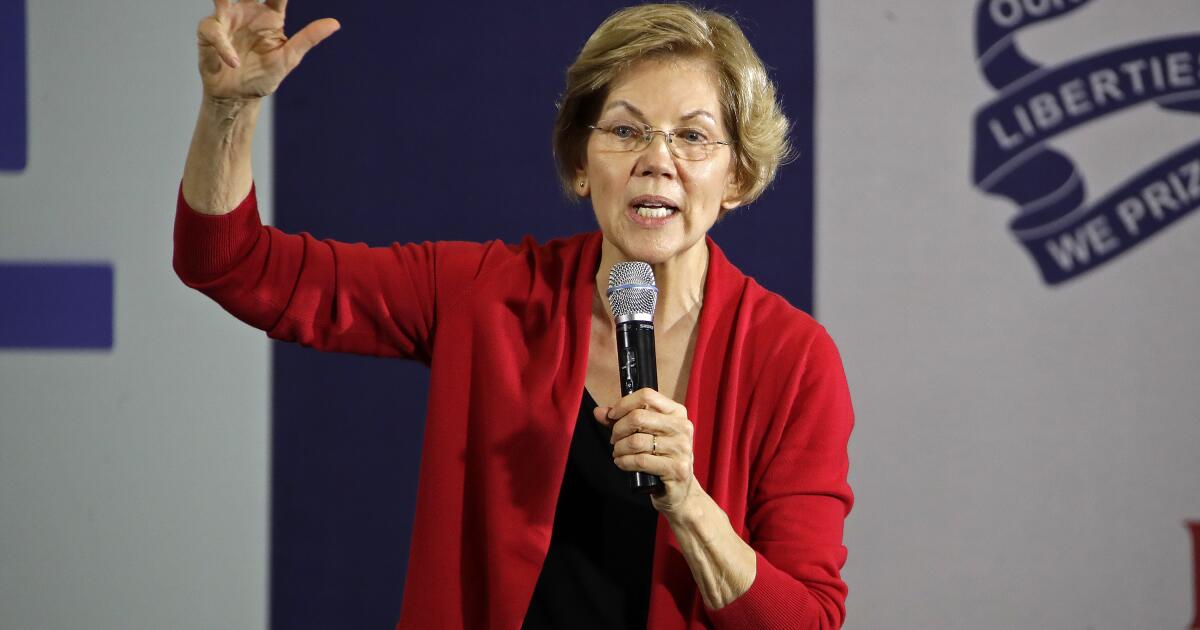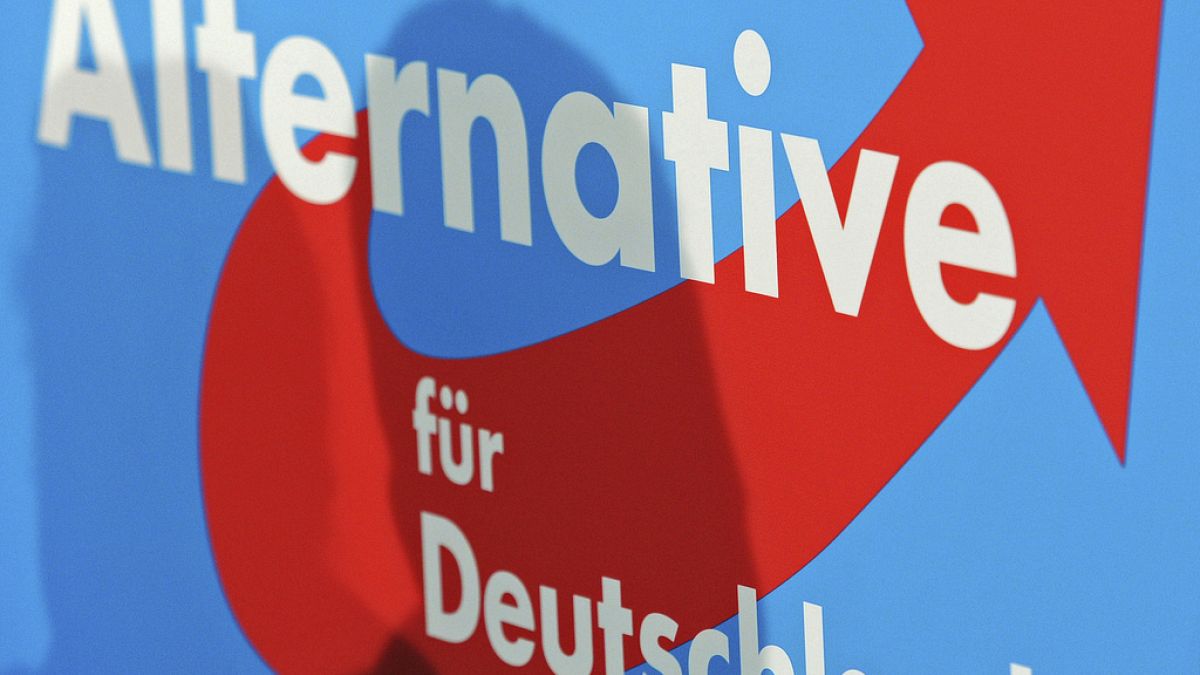Politics
Video: Katie Britt Attacks Biden in G.O.P. Response

new video loaded: Katie Britt Attacks Biden in G.O.P. Response
transcript
transcript
Katie Britt Attacks Biden in G.O.P. Response
Seated at her kitchen table in Montgomery, Ala., the Republican senator called President Biden “a dithering and diminished leader” and addressed issues including immigration and I.V.F.
-
Like so many families across America, my husband, Wesley, and I just watched President Biden’s State of the Union address from our living room, and what we saw was the performance of a permanent politician who has actually been in office for longer than I’ve been alive. President Biden’s border policies are a disgrace. This crisis is despicable. And the truth is, it is almost entirely preventable. Right now, our commander in chief is not in command. The free world deserves better than a dithering and diminished leader. We want families to grow. It’s why we strongly support continued nationwide access to in vitro fertilization. We want to help loving moms and dads bring precious life into this world.
Recent episodes in Politics

Politics
Supreme Court rejects payday lenders' challenge to Obama-era consumer protection bureau

The Supreme Court on Thursday upheld the U.S. consumer protection agency that was created under President Obama and congressional Democrats to protect Americans from financial scams.
By a 7-2 vote, the justices rejected a constitutional claim brought by a coalition of payday lenders who had won before a panel of three Trump appointees on the 5th Circuit Court of Appeals.
The lower court had questioned the legality of the agency, ruling it was not properly “accountable to Congress” because it did not receive its funding through an annual appropriation.
Writing for the majority, Justice Clarence Thomas said early American history shows that Congress could fund the government through different means, not just through an annual appropriation.
“Based on the Constitution’s text, the history against which that text was enacted, and congressional practice immediately following ratification, we conclude that appropriations need only identify a source of public funds and authorize the expenditure of those funds for designated purposes to satisfy the appropriations clause,” he wrote in CFPB vs. Consumer Financial Services Association.
Justices Samuel A. Alito Jr. and Neil M. Gorsuch dissented.
Alito faulted the court for upholding “a novel statutory scheme under which the powerful CFPB may bankroll its own agenda without any congressional control or oversight.”
Consumer advocates welcomed the decision.
“This ruling upholds the independent funding structure that has made the CFPB a successful advocate for protecting consumers and holding big banks, payday lenders, and other financial institutions accountable,” said Devon Ombres, a legal policy director for the Center for American Progress. A ruling upholding the 5th Circuit Court “could have placed the entire financial regulatory system at risk and roiled financial markets.”
“Predatory lenders and companies that rip consumers off with illegal junk fees have been trying to undermine the CFPB since it was created,” said Lauren Saunders, associate director of the National Consumer Law Center.
In creating the new bureau, Congress decided to fund it with lending fees from the Federal Reserve. If the Supreme Court had ruled such funding was unconstitutional, its decision would have cast doubt on the Federal Reserve as well.
In defense of the bureau, Biden administration attorneys argued that throughout American history, Congress has created agencies and bureaus such as the Post Office, the National Mint, the Customs Bureau and the Patent Office which were funded by fees, not an annual appropriation from Congress.
The CFPB called the decision “a resounding victory for American families and honest businesses alike, ensuring that consumers are protected from predatory corporations and that markets are fair, transparent, and competitive…For years, lawbreaking companies and Wall Street lobbyists have been scheming to defund essential consumer protection enforcement.”
Its statement said that since bureau opened its doors in 2011, “it has delivered more than $20 billion in consumer relief to hundreds of millions of consumers and has handled more than 4 million consumer complaints.”
Thursday’s decision is the latest sign that the Supreme Court’s conservatives are not ready to rubber stamp far-right rulings from Trump-appointed judges in Texas and Louisiana.
On Wednesday, the justices set aside a decision by two Trump appointees in Louisiana which would have blocked the use of new state election map with two majority Black districts.
Still pending before the court is a conservative challenge to the availability of abortion medication. Since 2000, the Food and Drug Administration has said these pills are safe and effective for ending early pregnancies. But anti-abortion doctors went to Texas and won rulings that could strictly limit dispensing the pills.
The consumer protection bureau that was upheld Thursday was conceived by Sen. Elizabeth Warren (D-Mass.) when she was a law professor.
The bureau became the centerpiece of the 2010 Dodd-Frank overhaul of financial regulations following the collapse of the mortgage market.
Its mission was to protect borrowers and consumers from deceptive and unfair practices by banks and mortgage lenders.
But it has been steadily opposed by much of the lending industry and by many Republicans who say the agency has too much unchecked power.
Congressional Democrats who created the bureau tried to shield it from the politics of Washington but that led to problems in the courts.
Under the 2010 legislation, the bureau’s director could not be removed by the president for political reasons, and the bureau’s budget was off-limits to Congress’ annual process of appropriations. Instead, its funding comes from the Federal Reserve, which earns fees from lending. The bureau used $641 million of that money last year.
The Supreme Court’s conservatives had cast a skeptical eye on the bureau. Four years ago, the justices in a 5-4 decision rejected the independent status of the director and ruled that person could be removed by the president for any reason, including political differences.
The current dispute began as a challenge to a proposed regulation of payday lenders.
In ruling for the lenders, the three judges of the 5th Circuit, all appointees of President Trump, said it violated the Constitution to shield the bureau from an annual fight over its appropriation.
Judge Cory Wilson said the “bureau’s perpetual insulation from Congress’ appropriations power, including the express exemption from congressional review of its funding, renders it … no longer accountable to Congress and, ultimately, to the people.”
Politics
One Area Where Biden Is Leading Trump: His Number of Donors

President Biden may be struggling in national polls, but he recently overtook former President Donald J. Trump in at least one important measure: the total number of donors who have given to his campaign, which is often seen as a proxy for voter engagement.
Where each candidate has more donors or
fewer donors compared with 2020, by county
Across most of the country, Mr. Trump has fewer donors than he did at the same time in 2020, while Mr. Biden has more.
Detailed maps of where people have donated to the Trump and Biden campaigns in 2024 and in 2020 show that Mr. Biden is overperforming and that Mr. Trump is underperforming in many of the battleground states they will need to win, in comparison with where they were at this point in the 2020 cycle.
As of the end of March, Mr. Biden had 1.1 million unique individual donors, compared with one million for Mr. Trump. The difference is apparent in their total fund-raising hauls: Mr. Biden’s campaign committee has taken in nearly $160 million so far in this election cycle, compared with Mr. Trump’s $114 million.
The rematch between the two candidates offers an unusual opportunity for comparison. A New York Times analysis of data on individual donors from filings with the Federal Election Commission shows that Mr. Trump had fewer individual donors at the end of March than he did at the same time in 2020, while Mr. Biden had more than he did in 2020.
Note: Lines show the total number of unique individual donors who gave to either Trump or Biden by the date of their first donation.
The New York Times
Mr. Biden’s robust fund-raising is in stark contrast to his weakness in the polls. New surveys from The Times, Siena College and The Philadelphia Inquirer show him trailing Mr. Trump in several crucial battleground states, as Mr. Biden’s popularity has eroded among young people and voters of color.
The two candidates’ positions have reversed since March 2020, when Mr. Trump was running for re-election and Mr. Biden was closing in on his party’s nomination.
Mr. Biden was a late-breaking favorite in the 2020 primary race, having lagged for months in the polls behind his Democratic rivals. He became the party’s presumptive nominee on April 8, after the withdrawal of Senator Bernie Sanders of Vermont.
This year, Mr. Trump was long the prohibitive favorite in the Republican primary race, but did not become the presumptive nominee until early March, when his last opponent, Nikki Haley, bowed out of the contest.
The changing circumstances between March 2020 and this year are also apparent outside of battleground states, when total donors to both candidates are compared with the previous cycle.
In Delaware, Mr. Biden has roughly twice as many donors as Mr. Trump, an analysis of contributions by ZIP codes shows. But compared with March 2020, he has lost ground to Mr. Trump – which makes sense, because Mr. Biden’s home state was the early donor engine of his primary campaign in 2019 and early 2020.
Where each candidate has more donors or
fewer donors compared with 2020, by ZIP code
In New York City, Mr. Biden had a slight rise in donors relative to March 2020, while his number of donors in Manhattan has fallen steeply. The shift likely reflects his late emergence at the time as the party’s nominee. Mr. Trump has picked up donor support just outside the city on Long Island, which has been trending toward the Republican Party.
Where each candidate has more donors or
fewer donors compared with 2020, by ZIP code
In Arizona, which is a battleground state in 2024, Mr. Biden has picked up donors. He won the state in 2020 but trails Mr. Trump in 2024 polls there.
On close inspection, a few ZIP codes stand out. At the end of March 2020, Mr. Biden had about 150 donors in the ZIP code 86001, which makes up part of Flagstaff. This year, he had almost 300. Mr. Trump’s donors there declined to about 130 from about 150. Many ZIP codes around Tucson, Phoenix and Scottsdale also had an increase in Biden donors.
In neighboring Nevada, Mr. Trump has generally drawn more donors in the Las Vegas area than he did in 2020. The Times’s latest polls found that Mr. Biden’s support in that state had dropped from 2020.
Where each candidate has more donors or
fewer donors compared with 2020, by ZIP code
In Michigan, Mr. Biden had about 11 percent more donors than in 2020, driven by gains around Ann Arbor and in more traditionally conservative western parts of the state. But Mr. Biden did not gain donors in Dearborn, which has more residents with Middle Eastern ancestry or in Detroit, which is majority Black. Mr. Trump’s number of donors in the state fell by 8 percent, mostly because of dips in the Detroit suburbs and near Grand Rapids.
The latest Times/Siena polls show Mr. Trump leading among registered voters in Michigan, another battleground state.
Where each candidate has more donors orNorth Carolina and South Carolina
fewer donors compared with 2020, by ZIP code
The shifts in North Carolina and South Carolina are another illustration of how circumstances have changed for the two candidates. In South Carolina, Mr. Biden has lost donors compared with where he was in 2020, which makes sense: In 2020, the state had a competitive Democratic primary, which Mr. Biden won, setting off his march to the nomination. This year, it was Mr. Trump who had the competitive primary in South Carolina.
In North Carolina, a battleground state, Mr. Biden has gained donors relative to Mr. Trump since 2020. This could be welcome news for Democrats, who see the state as potentially winnable for Mr. Biden, after Mr. Trump won it narrowly in 2020.
Notes: Bars show the estimated number of individual donors who have given to each candidate in each state as of March 31. Numbers are estimates because of potential duplicate names or changes of address within the data.
The New York Times Methodology
Data includes donations reported to the Federal Election Commission by the Trump 2020 campaign, the Trump 2024 campaign, Trump Make America Great Again Committee, the Trump Victory joint fund-raising committee, Trump Save America Joint Fundraising Committee, Trump 47 Committee, Trump National Committee JFC, the Biden campaign, the Biden Victory Fund joint fund-raising committee and the Biden Action Fund joint fund-raising committee. Additional donations processed on behalf of those committees and reported by the online fund-raising platforms ActBlue and WinRed are also included.
The estimated number of individual donors was determined based on a unique combination of contributor name, state and ZIP code. Donors with invalid addresses were filtered out of the analysis. Dates of first donation were determined by the earliest contribution date for a unique individual donor to a 2020 or 2024 committee affiliated with either candidate.
Donations are counted through March 31 starting from the earliest announcement by one of the two candidates each cycle: April 25, 2019, for Mr. Biden in the 2020 cycle and November 15, 2022, for Mr. Trump in the 2024 cycle. Areas where the number of donors changed by five or fewer are not shown.
Donors in battleground states in the 2024 cycle
Politics
Southern border migrant encounters decrease slightly but gotaways still surge under Biden

The U.S. Border Patrol recorded ar decline in migrant encounters in April, the U.S. Customs and Border Protection (CBP) said in a news release Wednesday.
In April, the Border Patrol recorded 128,900 encounters between ports of entry along the southwest border. The figure was 30% lower than in April 2023, and 6% lower than in March.
“CBP continues to surge resources and personnel to impacted sectors along the border to ensure the safe, swift, and orderly processing of individuals to maximize expedited removals,” Troy Miller, a senior official performing the duties of the commissioner, said in a statement.
DHS’ FAILURE TO FILE PAPERWORK HAS LED TO 200K IMMIGRATION COURT CASES TOSSED UNDER PRESIDENT BIDEN: TRAC
A group of over 100 migrants attempting to enter the U.S. illegally rush a border wall on March 21. Migrant encounters at the southern border declined slightly in April, border officials said. (James Breeden for New York Post / Mega)
Despite the decline, separate figures obtained by Fox News revealed there were 1.6 million known gotaways from fiscal year 2021 to fiscal year 2023. In the decade of FY 2010 through FY 2020, under former Presidents Obama and Trump, authorities recorded more than 1.4 million known gotaways.
Known gotaways are illegal immigrants seen or detected via cameras, sensors, footings, etc., but are never apprehended.
“If a person is willing to put themselves into harm’s way crossing through very remote, very dangerous conditions to evade capture, you have to ask yourself why. What makes them willing to take that risk?” Border Patrol Chief Jason Owens asked a House committee in May 2023.
BORDER PATROL OFFICIALS SAY THREAT POSED BY ‘GOTAWAYS’ AT SOUTHERN BORDER ‘KEEPS US UP AT NIGHT’

President Biden has recently touted the decline in illegal border crossings. Border authorities on Wednesday said the number of migrant encounters declined in April. (Getty Images)
“That’s of concern to me. What’s also of concern to me is I don’t know who that individual is,” he added. “I don’t know where they came from. I don’t know what their intention is. I don’t know what they brought with them. That unknown represents a risk, a threat. It’s of great concern to anybody that wears this uniform.”
In April, CBP processed 41,400 people through appointments at ports of entry submitted on the CBP One app, authorities said. Since the app was introduced in January 2023, more than 591,000 people have scheduled appointments to present at ports of entry, CBP said.
Homeland Security Secretary Alejandro Mayorkas, who has been heavily criticized for the record numbers of migrants entering the U.S., has previously noted changes in migration flow in correspondence with Congress.
“Before 2013, the majority of individuals attempting to cross the border entered without being caught,” he said in a letter in January to the House Homeland Security Committee. “Under this administration, the estimated annual apprehension rate has averaged 78%, the same average rate of apprehension as in the prior administration.”
Fox News Digital’s Adam Shaw and Bill Melugin contributed to this report.
-

 News1 week ago
News1 week agoCompass Direct LLC’s 2024 Registration in North Carolina
-

 News1 week ago
News1 week agoMan, 75, confesses to killing wife in hospital because he couldn’t afford her care, court documents say
-

 World1 week ago
World1 week agoPentagon chief confirms US pause on weapons shipment to Israel
-

 Politics1 week ago
Politics1 week agoRFK Jr said a worm ate part of his brain and died in his head
-

 World1 week ago
World1 week agoConvicted MEP's expense claims must be published: EU court
-

 Politics1 week ago
Politics1 week agoBiden takes role as bystander on border and campus protests, surrenders the bully pulpit
-

 Politics1 week ago
Politics1 week agoHere's what GOP rebels want from Johnson amid threats to oust him from speakership
-

 World1 week ago
World1 week agoPro-Palestine protests: How some universities reached deals with students



















